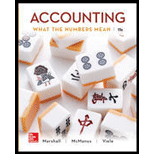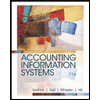
Case 8.36
LO 1, 2, 7
Capstone analytical review of Chapters 6-8. Analyzing capital leases, notes payable,
Mr. Gerrard: I’ve been talking with my accountant about our capital expansion needs, which will be considerable during the next couple of years. To stay in a strong competitive position, we’re constantly buying new pieces of earthmoving equipment and replacing machinery that has become obsolete. What it all comes down to is financing, and it’s not easy to raise $20 million to $40 million all at once. There are a number of options, including dealer financing, but the interest rates offered by banks are usually lower.
Your reply: From reviewing your
Mr. Gerrard: Actually we use several banks and we have an excellent credit history, so getting the money is not a major problem. The problem is that we already owe more, than $100 million and I don’t want to get overextended.
Your reply: Have you considered long-term leases?
Mr. Gerrard: Yes. This is essentially how dealer financing works. Usually it is arranged as a lease with an option to buy the equipment after a number of years. We’ve been actively looking into this with our Cat dealer for several scrapers that we need to put on a big job immediately. I can show you one of the contracts involved.
Your reply: OK, I’ll have a look at the contract, but this sounds like a long-term capital lease.
Mr. Gerrard: Yes, I think that’s what my accountant called it. What matters most to me is that we get the equipment in place ASAP; but if you could explain what the accounting implications would be of entering into these types of arrangements, that might put me at ease about it.
Your reply: No problem: will do. It would impact both your balance sheet and income statement, but in most respects a long-term capital lease is treated very much like a long-term note, payable, with a bank. I’ll give you a memo about it. But what about looking into other sources of equity financing? Have, you considered any of these options?
Mr. Gerrard: We’re a family business and want to keep it that way. Our shares are publicly traded, but we’re owned mostly by family members and employees. We’ve got a lot of
Should we be issuing bonds?
Your reply: Issuing bonds is possible, but I was thinking more on the lines of preferred stock. Are you familiar with this option?
Mr. Gerrard: Not really. Isn’t preferred stock a lot like bonds payable?
Your reply: Maybe this is something else I should include in my memo: an explanation of the differences between common stock, preferred stock, and bonds payable.
Mr. Gerrard: Yes, please do.
Required:
- When discussing capital leases with Mr. Gerrard, you commented, “It would impact both your balance sheet and income statement, but in most respects a long-term capital lease is treated very much like a long-term note payable with a hank.” Explain the accounting treatment of capital leases as compared to the accounting treatment of notes payable in terms that a nonaccountant could easily understand. Include in your answer both the balance sheet and income statement effects of capital leases. (Note: You do not need to make reference to the four criteria for capitalizing a lease.)
- Assume you have reviewed the contract Mr. Gerrard provided concerning the dealer financing agreement for the purchase of two new’ scrapers. You have determined that the lease agreement would qualify as a capital lease. The present value of the lease payments would be $4 million. Use the horizontal model, or write the
journal entry , to show Mr. Gerrard how page 311 this lease would affect the financial statements of Gerrard Construction Co. - Explain what Mr. Gerrard meant by this statement: “We’ve got a lot of retained earnings, but that’s not the same thing as cash, you know'.” Review the balance sheet at December 31, 2016, provided in Case 4.30. In which assets are most of the company’s retained earnings invested?
- Explain to Mr. Gerrard what the similarities and differences are between bonds payable, preferred stock, and common stock.
- Why would you recommend to Mr. Gerrard that his company consider issuing $20 million to $40 million of preferred stock rather than bonds payable? (Hint: Review the company’s balance sheet provided in Case 4.30 in the context of your present conversation with Mr. Gerrard.)
Want to see the full answer?
Check out a sample textbook solution
Chapter 8 Solutions
Accounting: What the Numbers Mean
- Could you help me solve this financial accounting question using appropriate calculation techniques?arrow_forwardCaldwell Electronic Devices produces smartphone accessories. Estimated sales (in units) are 62,000 in July, 54,000 in August, and 49,500 in September. Each unit is priced at $35. Caldwell wants to have 45% of the following month's sales in ending inventory. That requirement was met on July 1. Each accessory requires 3 components and 8 feet of specialized cabling. Components cost $4 each, and cabling is $0.75 per foot. Caldwell wants to have 30% of the following month's production needs in ending raw materials inventory. On July 1, Caldwell had 45,000 components and 120,000 feet of cabling in inventory. What is Caldwell's expected sales revenue for August?arrow_forwardEinstein 2023 balance sheet showed net fixed assets of $3.1 million, while its 2022 balance sheet showed net fixed assets of $2.9 million. Its 2023 income statement reported a depreciation expense of $280,000. How much did Jason spend to acquire new fixed assets during 2023?arrow_forward
 Cornerstones of Financial AccountingAccountingISBN:9781337690881Author:Jay Rich, Jeff JonesPublisher:Cengage Learning
Cornerstones of Financial AccountingAccountingISBN:9781337690881Author:Jay Rich, Jeff JonesPublisher:Cengage Learning Financial Accounting: The Impact on Decision Make...AccountingISBN:9781305654174Author:Gary A. Porter, Curtis L. NortonPublisher:Cengage Learning
Financial Accounting: The Impact on Decision Make...AccountingISBN:9781305654174Author:Gary A. Porter, Curtis L. NortonPublisher:Cengage Learning Excel Applications for Accounting PrinciplesAccountingISBN:9781111581565Author:Gaylord N. SmithPublisher:Cengage Learning
Excel Applications for Accounting PrinciplesAccountingISBN:9781111581565Author:Gaylord N. SmithPublisher:Cengage Learning Accounting Information SystemsFinanceISBN:9781337552127Author:Ulric J. Gelinas, Richard B. Dull, Patrick Wheeler, Mary Callahan HillPublisher:Cengage Learning
Accounting Information SystemsFinanceISBN:9781337552127Author:Ulric J. Gelinas, Richard B. Dull, Patrick Wheeler, Mary Callahan HillPublisher:Cengage Learning Financial AccountingAccountingISBN:9781337272124Author:Carl Warren, James M. Reeve, Jonathan DuchacPublisher:Cengage Learning
Financial AccountingAccountingISBN:9781337272124Author:Carl Warren, James M. Reeve, Jonathan DuchacPublisher:Cengage Learning Financial Reporting, Financial Statement Analysis...FinanceISBN:9781285190907Author:James M. Wahlen, Stephen P. Baginski, Mark BradshawPublisher:Cengage Learning
Financial Reporting, Financial Statement Analysis...FinanceISBN:9781285190907Author:James M. Wahlen, Stephen P. Baginski, Mark BradshawPublisher:Cengage Learning





